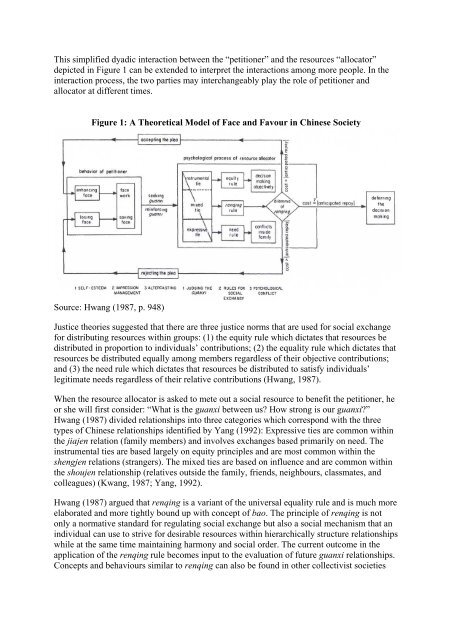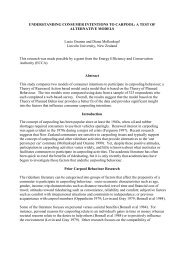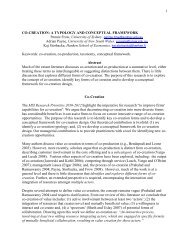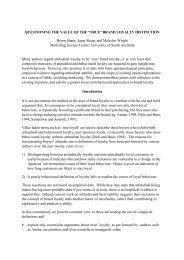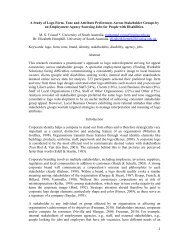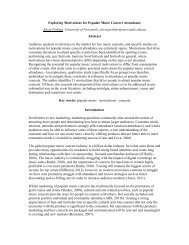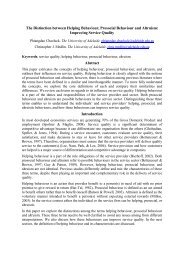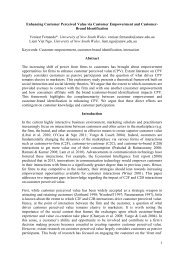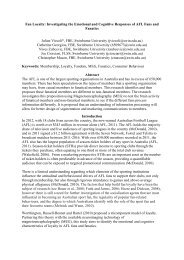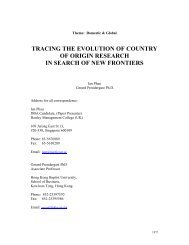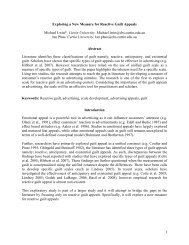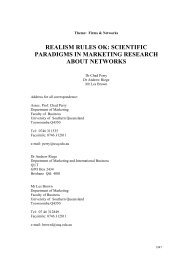The Chinese Concepts of Guanxi, Mianzi, Renqing and ... - ANZMAC
The Chinese Concepts of Guanxi, Mianzi, Renqing and ... - ANZMAC
The Chinese Concepts of Guanxi, Mianzi, Renqing and ... - ANZMAC
You also want an ePaper? Increase the reach of your titles
YUMPU automatically turns print PDFs into web optimized ePapers that Google loves.
This simplified dyadic interaction between the “petitioner” <strong>and</strong> the resources “allocator”<br />
depicted in Figure 1 can be extended to interpret the interactions among more people. In the<br />
interaction process, the two parties may interchangeably play the role <strong>of</strong> petitioner <strong>and</strong><br />
allocator at different times.<br />
Figure 1: A <strong>The</strong>oretical Model <strong>of</strong> Face <strong>and</strong> Favour in <strong>Chinese</strong> Society<br />
Source: Hwang (1987, p. 948)<br />
Justice theories suggested that there are three justice norms that are used for social exchange<br />
for distributing resources within groups: (1) the equity rule which dictates that resources be<br />
distributed in proportion to individuals’ contributions; (2) the equality rule which dictates that<br />
resources be distributed equally among members regardless <strong>of</strong> their objective contributions;<br />
<strong>and</strong> (3) the need rule which dictates that resources be distributed to satisfy individuals’<br />
legitimate needs regardless <strong>of</strong> their relative contributions (Hwang, 1987).<br />
When the resource allocator is asked to mete out a social resource to benefit the petitioner, he<br />
or she will first consider: “What is the guanxi between us? How strong is our guanxi?”<br />
Hwang (1987) divided relationships into three categories which correspond with the three<br />
types <strong>of</strong> <strong>Chinese</strong> relationships identified by Yang (1992): Expressive ties are common within<br />
the jiajen relation (family members) <strong>and</strong> involves exchanges based primarily on need. <strong>The</strong><br />
instrumental ties are based largely on equity principles <strong>and</strong> are most common within the<br />
shengjen relations (strangers). <strong>The</strong> mixed ties are based on influence <strong>and</strong> are common within<br />
the shoujen relationship (relatives outside the family, friends, neighbours, classmates, <strong>and</strong><br />
colleagues) (Kwang, 1987; Yang, 1992).<br />
Hwang (1987) argued that renqing is a variant <strong>of</strong> the universal equality rule <strong>and</strong> is much more<br />
elaborated <strong>and</strong> more tightly bound up with concept <strong>of</strong> bao. <strong>The</strong> principle <strong>of</strong> renqing is not<br />
only a normative st<strong>and</strong>ard for regulating social exchange but also a social mechanism that an<br />
individual can use to strive for desirable resources within hierarchically structure relationships<br />
while at the same time maintaining harmony <strong>and</strong> social order. <strong>The</strong> current outcome in the<br />
application <strong>of</strong> the renqing rule becomes input to the evaluation <strong>of</strong> future guanxi relationships.<br />
<strong>Concepts</strong> <strong>and</strong> behaviours similar to renqing can also be found in other collectivist societies


